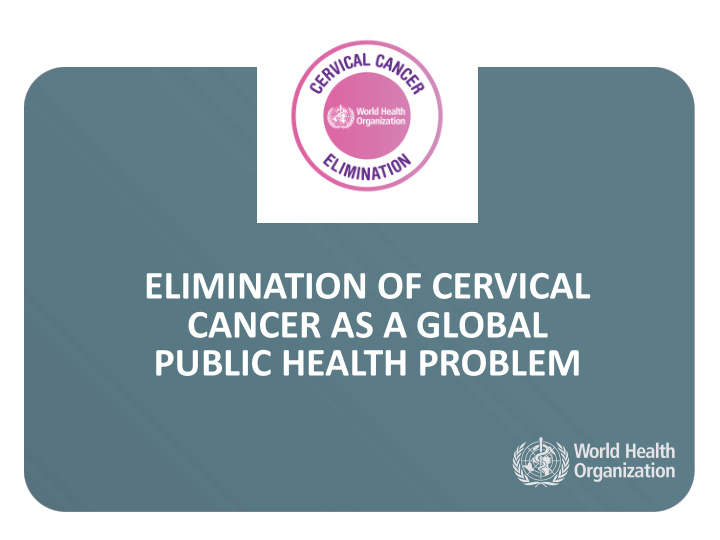



ELIMINATION OF CERVICAL CANCER AS A GLOBAL PUBLIC HEALTH PROBLEM
GROWING INEQUITIES AND PUBLIC HEALTH THREAT OF CERVICAL CANCER (GLOBOCAN 2018)
WHO LIFE COURSE APPROACH TO CERVICAL CANCER CONTROL Primary Prevention Secondary Prevention Tertiary Prevention
VARIABILITY IN CERVICAL CANCER INCIDENCE RATES BY WORLD REGION
CERVICAL CANCER ELIMINATION: CONCEPTUAL FRAMEWORK Current vaccination and Cervical cancer cases/100,000 screening Intensive screening Intensive vaccination and vaccinaMon 2060 2120 2020 2030
INCREASING ACCESS TO INTERVENTIONS 2030 VACCINATION, SCREENING & TREATMENT COVERAGE TARGETS Control : Targets of Elimination by 90/70/90 2085 /2090 Cervical cancer cases/100,000 Elimination at 4 / 100,000 2060 2120 2020 2030
THE ARCHITECTURE TO ELIMINATE CERVICAL CANCER: VISION : A world without cervical cancer THRESHOLD: All countries to reach < 4 cases 100,000 women-years 2030 CONTROL TARGETS 90% 70% 90% of girls fully vaccinated of women screened with an of women identified with with HPV vaccine by 15 high precision test at 35 cervical disease receive years of age and 45 years of age treatment and care SDG 2030 : Target 3.4 – 30% reduction in mortality from cervical cancer The 2030 targets and elimination threshold are subject to revision depending on the outcomes of the modeling and the WHO approval process
92 Countries included HPV vaccine in the national immunization programme (Feb 2019)
Reported HPV vaccine coverage of various ages, 2014-2016 90% coverage is achievable, but most countries are far behind 100 90 80 70 60 50 % 40 30 20 10 0 Bot Sey Chi Col Nor Swe Swi Bhu Coo Mau Rwa SA Ug Arg Bar Bel Bra Can Ecu Hon Mex Pan Par Per Sur USA Uru Aut Bel Den Fin Fra Ger Hun Ice Ire Ita Lat Mac Mal Net Por Slo Spa UK Aus Bru Fij Mal Nzl Pal AFR AMR EUR SEAR WPR Source: Brotherton & Bloem, 2017
Cervical cancer screening : proportion of women between 30 – 49 screened for cervical cancer at least once Bahamas (2013 ) Belarus (2016) Saint Lucia (2012) Saint Kitts and Nevis (2008) Bermuda (2 014) Tokelau (201 4) Anguilla (2016) Republic of Moldova (20 14) Brunei Darussalam (2015) Dominica (2008) Bhutan (2014) Turkmenistan (2014) Nauru (2016) Thailand (2007) Mongolia (2013) Trinidad and Tobago (2012) Turkey (2017) Kyrgyzstan (201 3) Ar menia (2016) Viet Nam (2015) Jordan (2007) Tuvalu (2015 ) Georgia (2016) Swaziland (201 4) Zambia (2017) Lebanon (2017) Kuwait (2014) Malawi (2017) Kenya (2015) Algeria (2016) Solomon Islands (2015) Uzbekistan (2014) Morocco (2017) Tajikistan (2016) Azerbaijan (2017) Senegal (2015) Uganda (2014) Iraq (2015) Bur kina Faso (2013) Myanmar (2014) Ethiopia (2015) Sudan (2016) Egypt (2017) Timor-Leste (2014) Pakistan (2013) Benin (2015) 0.0% 10.0% 20.0% 30.0% 40.0% 50.0% 60.0% 70.0% 80.0% 90.0% 100.0% % of women aged 30-49 Source: WHO STEPS
Strategy towards the elimination of cervical cancer as a global public health problem: key outputs VISION : A world without cervical cancer Guiding principles: life course and public health approach, social 1 justice and equity, integrated people-centered health services 2 Increased Increased Increased coverage of coverage of coverage of HPV screening & diagnosis & vaccinaMon treatment of treatment for pre-cancer invasive lesions cancer and palliative care 3 Accelerators
ACHIEVING 90% COVERAGE OF HPV VACCINATION WHO recommendations 2 doses to girls 9-14 , minimum 6 months apart • • Introduce to multi-age cohort, 9-14 yrs ( 15-18 if feasible) in first year • 3 doses for: girls 15 y and older; and for immuno-compromised individuals Challenges Limited supply of the HPV vaccine • Vaccine not affordable and high delivery cost • ABer introducCon vaccinaCon coverage low in many countries due to factors like choice of • delivery strategy, insufficient communicaCon and hesitancy related factors Accelerators Sufficient, affordable supply of HPV vaccine Concerted effort between partners and private sector to overcome vaccine supply constraints • Introduction of HPV vaccine Coordinated initiative to identify and leverage sustainable resources from countries and from • donors/financing agencies to introduce vaccines in more countries Increased quality and coverage of service delivery Develop and implement high quality, multi-sectoral introduction plans • Use or develop sustainable and equitable delivery platforms • Develop high quality and sustained communication and mobilization approaches •
ACHIEVING 70% COVERAGE OF SCREENING AND TREATMENT OF PRECANCER LESIONS WHO recommendaMons • Women aged 30-49 be screened at least once in their lifehme for cervical cancer, and rescreened every 5 years. Women living with HIV should be screened every 3 years • • Immediate treatment where possible Challenges • Expensive and complex screen and treat technologies complicate scaling-up New or optimized service delivery methods required for LMIC contexts • Accelerators Sufficient, affordable supply of screen and treat technologies & products • • Prompt certification of new products • Price reductions • National scale-up of screen & treat Simple algorithms need to be introduced for different settings • Increased quality and coverage of service delivery • • Countries detailed implementation plans to introduce and scale-up products and delivery models • Strengthen patient retention and linkage to treatment
TOWARDS CERVICAL CANCER ELIMINATION STRATEGY: TIMELINE April– May https://www.who.int/cancer/cervical-cancer Web-based consultation Global consultation African regional consultation May 13-15 Eastern Mediterranean regional consultation June 18-20 Western Pacific regional consultation June 24-26 South East Asia regional consultation June 27-28 Americas regional consultation Aug 01-02 WHO RCM agenda item Aug-Sept Governing Bodies Meetings Executive Board Meeting Jan 2020 World Health Assembly May 2020
“Consign cervical cancer to the history books “
Recommend
More recommend